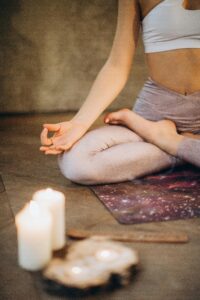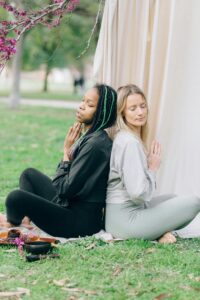Yoga, an ancient practice that originated in India, is a holistic discipline that combines physical postures, breathing exercises, and meditation to promote overall well-being. Its importance in enhancing flexibility and strength has made it increasingly popular worldwide. Practicing yoga not only improves physical health but also supports mental and emotional stability.
Benefits of Yoga
Physical Benefits
Improved Flexibility: Regular yoga practice gradually increases the range of motion in joints and muscles, leading to better flexibility.
Increased Strength: Yoga poses engage various muscle groups, helping to build strength and endurance.
Enhanced Balance: Many yoga poses require balance, improving coordination and stability over time.

Mental Benefits
Stress Reduction: Yoga’s emphasis on breathing and meditation helps reduce stress and promote relaxation.
Better Focus: Practicing yoga improves concentration and mental clarity.
Improved Sleep: The calming effects of yoga can lead to better sleep patterns and overall restfulness.
Types of Yoga
Hatha Yoga
A gentle introduction to the most basic yoga postures.
Vinyasa Yoga
A series of poses that flow smoothly into one another.
Ashtanga Yoga
A rigorous style that follows a specific sequence of postures and is similar to vinyasa yoga but faster-paced.
Iyengar Yoga
A form of yoga that uses props like belts, blocks, and wall ropes to help perform poses with correct alignment.
Bikram Yoga
Practiced in a room heated to a high temperature, consisting of a set sequence of 26 challenging poses.
Yin Yoga
A slower-paced style of yoga with poses that are held for longer periods of time to target deep connective tissues.
Basic Yoga Poses for Beginners
Mountain Pose (Tadasana)
A foundational pose for all standing postures, promoting proper alignment.
Downward Facing Dog (Adho Mukha Svanasana)
A key pose in many yoga practices, stretching the hamstrings and calves while strengthening the arms and shoulders.
Warrior I (Virabhadrasana I)
A powerful standing pose that strengthens the legs and arms while improving balance.
Warrior II (Virabhadrasana II)
Enhances stamina and stability, focusing on the hips, chest, and legs.

Tree Pose (Vrksasana)
A balancing pose that strengthens the legs and improves focus.
Cat-Cow Pose (Marjaryasana-Bitilasana)
A gentle flow between two poses that warms up the spine and relieves tension in the neck and back.
Child’s Pose (Balasana)
A resting pose that gently stretches the hips, thighs, and ankles while calming the mind.
Cobra Pose (Bhujangasana)
Strengthens the spine and opens the chest, shoulders, and abdomen.
How to Start a Yoga Practice
Setting Up a Space: Choose a quiet, comfortable area free of distractions.
Choosing the Right Yoga Mat: Invest in a good quality, non-slip yoga mat.
Wearing Appropriate Clothing: Opt for comfortable, stretchy clothing that allows for free movement.
Finding Beginner-Friendly Classes: Look for classes or online videos tailored to beginners.
Importance of Consistency: Regular practice is key to seeing progress in flexibility and strength.
Tips for Practicing Yoga Safely
Listening to Your Body: Pay attention to how your body feels and avoid pushing beyond your limits.
Avoiding Overexertion: Practice poses within your current ability to prevent injury.
Using Props: Utilize blocks, straps, and other props to help maintain proper alignment and support.
Modifying Poses: Adapt poses to fit your individual needs and capabilities.
Common Mistakes to Avoid
Holding Your Breath: Focus on maintaining a steady, even breath throughout your practice.
Rushing Through Poses: Take your time to move mindfully and with control.
Comparing Yourself to Others: Concentrate on your own practice and progress, not on others.
Not Warming Up Properly: Always start with a gentle warm-up to prepare your body for more intense poses.
Yoga for Flexibility
Poses that Target Flexibility
Forward Fold (Uttanasana): Stretches the hamstrings, calves, and hips.
Seated Forward Bend (Paschimottanasana): Targets the spine, shoulders, and hamstrings.
Pigeon Pose (Eka Pada Rajakapotasana): Opens the hips and stretches the thighs, groin, and psoas.
Bound Angle Pose (Baddha Konasana): Stretches the inner thighs, groins, and knees.
Stretching Routines
Incorporate a series of poses that specifically target tight areas to improve overall flexibility.
Yoga for Strength
Poses that Build Strength
Plank Pose (Phalakasana): Strengthens the arms, wrists, and core muscles.
Boat Pose (Navasana): Engages the core and strengthens the hip flexors and spine.
Chair Pose (Utkatasana): Works the muscles of the legs and glutes while engaging the core.
Crow Pose (Bakasana): Builds arm strength and improves balance and concentration.
Strength-Building Sequences
Create routines that combine various strength-building poses to enhance muscle tone and endurance.
Combining Yoga with Other Workouts
Yoga and Cardio: Combine yoga with cardiovascular exercises for a well-rounded fitness routine.
Yoga and Strength Training: Use yoga to complement traditional strength training for enhanced flexibility and muscle recovery.
Benefits of Cross-Training: Incorporating yoga into your fitness regimen can prevent injuries and improve overall performance.
Yoga and Mindfulness
The Connection Between Yoga and Meditation: Both practices focus on breath control and mental clarity.
Incorporating Mindfulness into Your Practice: Use mindfulness techniques during yoga to deepen the practice.
Breathing Exercises (Pranayama): Practice different breathing techniques to enhance your yoga sessions.
